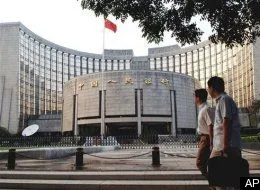
China’s interbank repo rate surges to 8%
The Royal Bank of Scotland says this resulted from the recent 50 point hike in the central bank’s reserve requirement ratio.
Tightening may ease if the PBoC chooses not to roll over the maturing bills which amounted to a total of RMB 88 bn this week.
Here’s more from RBSM:
| RBSM says the interbank market tightened significantly in the past two days, as the new reserve requirement, announced on June 14th, took effect yesterday. The seven day repo rate surged to 8% yesterday, compared to around 4% before the announcement, and rose further today. Seasonal factors also played a role. In order to meet the prudential requirement banks generally need to lower their end-of-quarter loan-to-deposit ratios; often other liabilities such as proceeds from maturing investment products are converted into regular deposits for this purpose. This would in turn require the placement of additional reserves with the central bank, which tends to tighten the liquidity further. The pressure may ease in coming days. For instance, if the PBoC decides not to roll over the maturing bills, amounting to about RMB 88 billion in total this week, mostly towards the later part, about 20% of the liquidity withdrawn through the RRR hike would be released back to the market. In fact, outside of the RRR hikes, the PBoC has been injecting liquidity through OMOs in recent weeks. For instance, during the last week alone, PBoC injected RMB113 billion. The greater reliance on RRR hikes to mop up liquidity helps to lower PBoC’s interest rate costs on the liability side (interest rates on reserves are lower than those on central bank bills ) while at the same time reducing the upward pressure on the issuance rates of PBoC bills with maturities of 3 month or longer. Liquidity inflows through FX intervention should also help to ease the market squeeze but the size of such inflows could be uncertain. On the monthly basis foreign exchange purchases average about RMB 360 billion recently, similar to the size of the funds locked up through each RRR hike. Increasingly the external inflows have been driven by capital flows rather than trade surplus and FDI, which may have added to the volatility of the interbank liquidity. On assumption of continued FX inflows (which is highly probable given the yield differentials between the on-shore and off-shore markets) we expect the RRR hikes to continue. |




![Lorem Ipsum [ABF 1]](https://cmg-qa.s3.ap-southeast-1.amazonaws.com/s3fs-public/styles/exclusive_featured_article/public/2025-03/a_hand_pointing_to_a_futuristic_technology_5b87c9d0e3_1.png.webp?itok=2w0y1WhS)


![Cross Domain [Manu + SBR + ABF + ABR + FMCG + HBR + ]](https://cmg-qa.s3.ap-southeast-1.amazonaws.com/s3fs-public/styles/exclusive_featured_article/public/2025-01/earth-3537401_1920_4.jpg.webp?itok=WaRpTJwE)







 Advertise
Advertise

